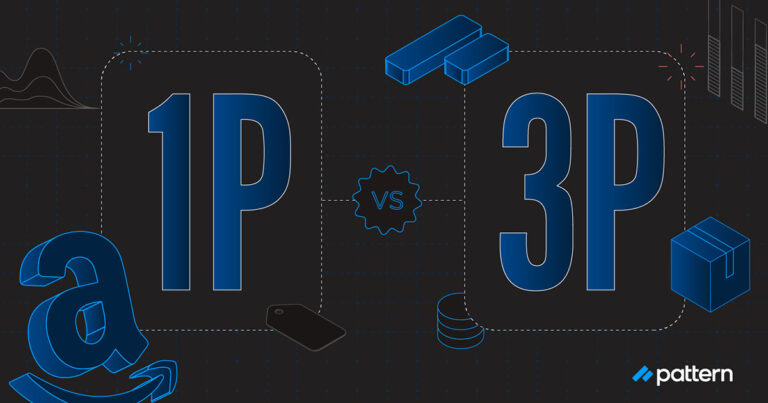If you’re trying to grow your ecommerce business and capture market share of the $6 trillion global ecommerce opportunity, you’ve probably heard about ecommerce accelerators—but what do they do for brands? And how do they differ from other ecommerce service providers, agencies, aggregators, technology companies, etc…?
As the premier global ecommerce accelerator, Pattern partners with brands in a data-driven and partner-obsessed way to drive profitable growth across ecommerce channels. Find out below what an accelerator is and the benefits you can expect to gain with a great ecommerce accelerator.
What is an Ecommerce Accelerator?
An ecommerce accelerator helps product brands sell better online through ecommerce acceleration. Ecommerce acceleration is the process of applying data-driven technology and expertise to increase revenue growth across major online ecommerce channels, including marketplaces like Amazon, Walmart, Target, Tmall, Mercado Libre, and beyond.
Accelerators Provide Ecommerce Strategy Execution
Time and time again, we see brands don’t have the resources they need to succeed on ecommerce marketplaces. And it’s no surprise—the ecommerce space is crowded, competitive, and vastly different from a traditional, brick-and-mortar sales model.
And, even though we know the ecommerce opportunity is vast and important to prioritize, many brands still get most of their revenue from brick-and-mortar channels and find it difficult to justify the resource spend needed to truly execute an ecommerce strategy well. It takes SEO experts, creative resources, data analysts, brand control experts, fulfillment specialists…the list goes on.
Brands have the choice to either ignore the common issues they’re experiencing on ecommerce channels or find outside help. We don’t recommend the first option—issues that seem small now will get out of hand fast, and the further problems develop, the more difficult it is to contain them. It’s doable to reverse damage due to loss of brand control, losing the buy box, issues with brick-and-mortar distributors, brand enforcement issues, and the dreaded Profitability Death Spiral. But it’s all the better to avoid them as much as possible in the first place.
Accelerators Are Invested in Their Brand Partners’ Success
Many brands, when faced with a lack of staff and resources to manage and control their ecommerce presence, turn to agencies or aggregators for help. Here’s where those two options are falling short:
Agencies
Ecommerce agencies aren’t the best option for true ecommerce success for a couple reasons:
- The price you pay to hire an agency doesn’t reflect the value you get out of the agreement. Agencies aren’t paid based on your success, they’re paid a fixed rate (plus overage), regardless of how your products perform. So, they’re not invested in making a large impact for your brand.
- Agencies often specialize in one aspect of ecommerce, such as SEO, making it necessary to hire multiple agencies to execute all aspects of your ecommerce strategy. This inflates your costs and causes vast alignment issues within your ecommerce plan.
Much like ecommerce agencies, accelerators support brands by driving traffic and conversions through proficiencies in advertising, SEO, content, design, and more. But accelerators go a step further to support supply chain logistics, increase brand control, and provide proprietary data—all with one partner.
Aggregators
Aggregators aren’t a great solution either. They’re interested in purchasing and growing brands, which sounds like a compelling idea, but, since all brands are unique, what works for one may not work for another. Therefore, the aggregator’s universal brand playbook often leads to poor product performance for brands. Brands acquired by aggregators often lose all control and ownership to the buyer as well.
Unlike ecommerce aggregators, who purchase brands in order to grow them, accelerators work in collaboration with the brand, supporting growth in exchange for a share of profits. Because of this, accelerators are highly motivated to help you succeed. They work with your brand to determine and maximize customer lifetime value but still give you full power of your brand strategy and decisions.
Accelerators Act as a True Partner in Growing Your Business
In our opinion, partnering with an ecommerce accelerator is the best way to gain control of your strategy and experience the healthiest and most profitable growth for your products. Here are some benefits of partnering with an ecommerce accelerator:
- Accelerators layer on the top of systems, processes, and teams you’re already using, and simply add the resources you’re missing to your strategy to fix issues and expand your presence across global marketplaces.
- An accelerator is paid differently—they agree to a profit margin with your brand, then take ownership of your products and strategy by buying your inventory. As your profitability grows, theirs does, too.
- Accelerators go a step further than helping brands with just SEO, content, advertising, and design. They also help to support supply chain logistics, increase brand control, and provide proprietary data—all with one partner.
- Accelerators can help you identify and capitalize on new opportunities for your brand, such as identifying product innovations, bundles, and shipping synergies, coaching you every step of the way.
Partner With a Global Ecommerce Accelerator Like Pattern
While brands can achieve acceleration on their own, the typical ecommerce team is small, under-resourced and lacks access to leading technology to achieve profitable scale. As a leading ecommerce accelerator, Pattern helps brands fill in their resource gaps, identify patterns in their data, and unleash profitable growth. Using our proprietary data suite, experience, and global reach, Pattern becomes an extension of your ecommerce team, supporting every aspect of your marketplace business from on-page imagery to warehousing logistics.
Want to learn more about accelerating your brand? Contact us.





